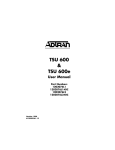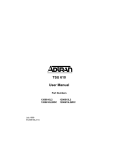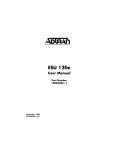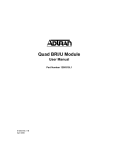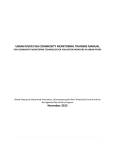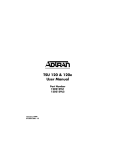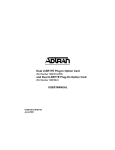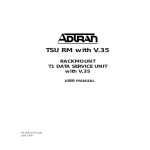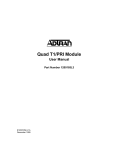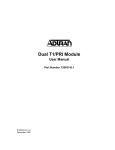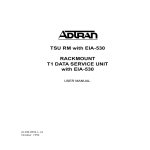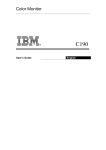Download SNMP Agent Module User Manual (Rev B)
Transcript
AGENT CARD USER MANUAL 61200160L1#HS-1B June 2000 Trademark Information Open View is a registered trademark of Hewlett-Packard Company. 901 Explorer Boulevard P.O. Box 140000 Huntsville, AL 35814-4000 (256) 963-8000 © 2000 ADTRAN, Inc. All Rights Reserved. Printed in U.S.A. Notes provide additional useful information. Cautions signify information that could prevent service interruption. Warnings provide information that could prevent damage to the equipment or endangerment to human life. iii FEDERAL COMMUNICATIONS COMMISSION RADIO FREQUENCY INTERFERENCE STATEMENT This equipment has been tested and found to comply with the limits for a Class A digital device, pursuant to Part 15 of the FCC Rules. These limits are designed to provide reasonable protection against harmful interference when the equipment is operated in a commercial environment. This equipment generates, uses, and can radiate radio frequency energy and, if not installed and used in accordance with the instruction manual, may cause harmful interference to radio frequencies. Operation of this equipment in a residential area is likely to cause harmful interference in which case the user will be required to correct the interference at his own expense. Shielded cables must be used with this unit to ensure compliance with Class A FCC limits. Change or modifications to this unit not expressly approved by the party responsible for compliance could void the user’s authority to operate the equipment. CANADIAN EMISSIONS REQUIREMENTS This digital apparatus does not exceed the Class A limits for radio noise emissions from digital apparatus as set out in the interference-causing equipment standard entitled “Digital Apparatus," ICES-003 of the Department of Communications. Cet appareil nuerique respecte les limites de bruits radioelectriques applicables aux appareils numeriques de Class A prescrites dans la norme sur le materiel brouilleur: "Appareils Numeriques," NMB-003 edictee par le ministre des Communications. iv CANADIAN EQUIPMENT LIMITATIONS Notice: The Canadian Industry and Science Canada label identifies certified equipment. This certification means that the equipment meets certain telecommunications network protective, operational, and safety requirements. The Department does not guarantee the equipment will operate to the user’s satisfaction. Before installing this equipment, users should ensure that it is permissible to be connected to the facilities of the local telecommunications company. The equipment must also be installed using an acceptable methods of connection. In some cases, the company’s inside wiring associated with a single line individual service may be extended by means of a certified connector assembly (telephone extension cord). The customer should be aware that compliance with the above limitations may not prevent degradation of service in some situations. Repairs to certified equipment should be made by an authorized Canadian maintenance facility designated by the supplier. Any repairs or alterations made by the user to this equipment, or equipment malfunctions, may give the telecommunications company cause to request the user to disconnect the equipment. Users should ensure for their own protection that the electrical ground connections of the power utility, telephone lines and internal metallic water pipe system, if present, are connected together. This precaution may be particularly important in rural areas. Users should not attempt to make such connections themselves, but should contract the appropriate electric inspection authority, or an electrician, as appropriate. The Load Number (LN) assigned to each terminal device denotes the percentage of the total load to be connected to a telephone loop which is used by the device, to prevent overloading. The termination on a loop may consist of any combination of devices subject only to the requirement that the total of the Load Numbers of all devices does not exceed 100. v IMPORTANT SAFETY INFORMATION SAVE THESE INSTRUCTIONS When using your telephone equipment, please follow these basic safety precautions to reduce the risk of fire, electrical shock, or personal injury: 1. Do not use this product near water, such as near a bathtub, wash bowl, kitchen sink, laundry tub, in a wet basement, or near a swimming pool. 2. 3. 4. Avoid using a telephone (other than a cordless-type) during an electrical storm. There is a remote risk of shock from lightning. Do not use the telephone to report a gas leak in the vicinity of the leak. Use only the power cord, power supply, and/or batteries indicated in the manual. Do not dispose of batteries in a fire. They may explode. Check with local codes for special disposal instructions. WARRANTY AND CUSTOMER SERVICE ADTRAN will replace or repair this product within five years from the date of shipment if it does not meet its published specifications or fails while in service. For detailed warranty, repair, and return information refer to the ADTRAN Equipment Warranty and Repair and Return Policy Procedure. Return Material Authorization (RMA) is required prior to returning equipment to ADTRAN. For service, RMA requests, or further information, contact one of the numbers listed on the back page of this manual. vi LIMITED PRODUCT WARRANTY ADTRAN warrants that for five (5) years from the date of shipment to Customer, all products manufactured by ADTRAN will be free from defects in materials and workmanship. ADTRAN also warrants that products will conform to the applicable specifications and drawings for such products, as contained in the Product Manual or in ADTRAN's internal specifications and drawings for such products (which may or may not be reflected in the Product Manual). This warranty only applies if Customer gives ADTRAN written notice of defects during the warranty period. Upon such notice, ADTRAN will, at its option, either repair or replace the defective item. If ADTRAN is unable, in a reasonable time, to repair or replace any equipment to a condition as warranted, Customer is entitled to a full refund of the purchase price upon return of the equipment to ADTRAN. This warranty applies only to the original purchaser and is not transferable without ADTRAN's express written permission. This warranty becomes null and void if Customer modifies or alters the equipment in any way, other than as specifically authorized by ADTRAN. EXCEPT FOR THE LIMITEDWARRANTY DESCRIBED ABOVE, THE FOREGOING CONSTITUTES THE SOLE AND EXCLUSIVE REMEDY OF THE CUSTOMER AND THE EXCLUSIVE LIABILITY OF ADTRAN AND IS IN LIEU OF ANY AND ALL OTHER WARRANTIES (EXPRESSED OR IMPLIED). ADTRAN SPECIFICALLY DISCLAIMS ALL OTHER WARRANTIES, INCLUDING (WITHOUT LIMITATION), ALL WARRANTIES OF MERCHANTABILITY AND FITNESS FOR A PARTICULAR PURPOSE. SOME STATES DO NOT ALLOW THE EXCLUSION OF IMPLIEDWARRANTIES, SO THIS EXCLUSION MAY NOT APPLY TO CUSTOMER. In no event will ADTRAN or its suppliers be liable to Customer for any incidental, special, punitive, exemplary or consequential damages experienced by either Customer or a third party (including, but not limited to, loss of data or information, loss of profits, or loss of use). ADTRAN is not liable for damages for any cause whatsoever (whether based in contract, tort, or otherwise) in excess of the amount paid for the item. Some states do not allow the limitation or exclusion of liability for incidental or consequential damages, so the above limitation or exclusion may not apply to Customer. vii viii Table of Contents List of Figures .......................................................................................................... xiii List of Tables .............................................................................................................xv Chapter 1. Introduction .......................................................................................... 1-1 AGent Card overview .............................................................................................. 1-1 Functional Description ............................................................................................ 1-2 Features................................................................................................................ 1-2 Agent Card Specifications................................................................................. 1-3 10-Base-T Interface ..................................................................................... 1-3 SLIP/EIA-232 Interface ............................................................................. 1-3 Chain-Out Interface ................................................................................... 1-4 Common ...................................................................................................... 1-4 MIB Support ................................................................................................ 1-4 Trap Support ............................................................................................... 1-4 Physical Description ................................................................................................. 1-5 Chapter 2. Installation ............................................................................................ 2-1 Unpack, Inspect, Power Up .................................................................................... 2-1 Receipt Inspection .............................................................................................. 2-1 ADTRAN Shipments Include........................................................................... 2-1 Provided by Customer ...................................................................................... 2-1 AGent Card Installation .......................................................................................... 2-2 Agent Card Placement....................................................................................... 2-2 Power Connection .............................................................................................. 2-3 Wiring .................................................................................................................. 2-3 Power-Up Testing and Initialization ..................................................................... 2-5 Successful Self Test............................................................................................. 2-5 Failed Self Test .................................................................................................... 2-5 Operation Alarms............................................................................................... 2-5 Chapter 3. Operation............................................................................................... 3-1 Overview ................................................................................................................... 3-1 Menu Structure ................................................................................................... 3-1 Menu Operation ................................................................................................. 3-1 61200160L1#HS-1 Agent Card User Manual ix Table of Contents Agent Card Configuration ...................................................................................... 3-3 Front Panel Menus .................................................................................................... 3-4 Port Status............................................................................................................3-4 10BaseT ........................................................................................................ 3-4 TX .......................................................................................................... 3-4 RX .......................................................................................................... 3-4 LNK ....................................................................................................... 3-4 CPU ....................................................................................................... 3-4 EIA-232 ........................................................................................................ 3-5 Chain Port .................................................................................................... 3-5 Flash Download .......................................................................................... 3-5 Port Configuration (PORT CONFIG) ..............................................................3-5 IP Interface ........................................................................................... 3-5 IP Address ............................................................................................ 3-6 Subnet Mask ......................................................................................... 3-6 Default Router ..................................................................................... 3-6 RS-232 Rate .......................................................................................... 3-6 RS-232 Flow Control ........................................................................... 3-6 Port Utility (PORT UTIL) .................................................................................. 3-6 SW REVISION ..................................................................................... 3-7 ENET ADDRESS ................................................................................. 3-7 telnet/terminal menus ............................................................................................. 3-7 Main Menu .......................................................................................................... 3-7 Host Menu Access ...................................................................................... 3-8 Remote Menu Access ................................................................................. 3-8 Unit Access Table ....................................................................................... 3-8 Add New Unit ..................................................................................... 3-9 Modify Unit ......................................................................................... 3-9 Delete Unit ........................................................................................... 3-9 Default Unit Passcode ...................................................................... 3-10 OK ....................................................................................................... 3-10 Management Configuration ................................................................... 3-10 SNMP Read Community ................................................................. 3-10 SNMP Read/Write Community ..................................................... 3-10 SNMP Trap Community .................................................................. 3-11 Host 1 Trap IP Address .................................................................... 3-11 Host 2 Trap IP Address .................................................................... 3-11 Host 3 Trap IP Address .................................................................... 3-11 Host 4 Trap IP Address .................................................................... 3-11 System Name ..................................................................................... 3-11 System Contact .................................................................................. 3-11 System Location ................................................................................ 3-11 x Agent Card User Manual 61200160L1#HS-1 Table of Contents Auth. Fail Traps Sent ....................................................................... 3-12 Poll Link Status Traps Sent .............................................................. 3-12 Ping IP Hosts ..................................................................................... 3-12 Exit ...................................................................................................... 3-12 TCP/IP Configuration ............................................................................. 3-12 TCP/IP Interface ............................................................................... 3-12 Agent IP Address .............................................................................. 3-12 Agent SUBNET Mask ....................................................................... 3-12 Default IP Router .............................................................................. 3-12 Telnet/Terminal Timeout ................................................................ 3-13 Telnet/Terminal Password ............................................................. 3-13 Exit ...................................................................................................... 3-13 RS-232 Configuration .............................................................................. 3-13 RS-232 Rate ........................................................................................ 3-13 RS-232 Flow Control ......................................................................... 3-13 Quit Session .............................................................................................. 3-13 Flash Download................................................................................................ 3-13 Appendix A. SNMP .............................................................................................. A-1 Appendix B. Agent Card Menu Tree .................................................................. B-1 Appendix C. Terminal Mode/Telnet Menu ..................................................... C-1 Appendix D. Agent Card Failure Messages ..................................................... D-1 Appendix E. Acronyms and Abbreviations ...................................................... E-1 61200160L1#HS-1 Agent Card User Manual xi Table of Contents xii Agent Card User Manual 61200160L1#HS-1 List of Figures Figure 1-1. Typical Agent Card Application......................................................... 1-2 Figure 1-2. Agent Option Module.......................................................................... 1-5 Figure 2-1. Installing the Agent Card .................................................................... 2-2 Figure 3-1. TSU 100 Main Menu............................................................................. 3-2 Figure 3-2. 10BaseT Status Display ........................................................................ 3-4 Figure 3-3. Telnet/Terminal Main Menu............................................................... 3-7 Figure 3-4. Unit Access Table .................................................................................. 3-9 Figure B-1. Agent Card Menu Tree ........................................................................B-1 Figure C-1. Terminal Mode/Telnet Menu Tree ................................................... C-1 61200160L1#HS-1 Agent Card User Manual xiii List of Figures xiv Agent Card User Manual 61200160L1#HS-1 List of Tables Table 2-1. 10-Base-T Ethernet.................................................................................. 2-3 Table 2-2. Pinout for EIA-232 Connector ............................................................. 2-4 Table 2-3. Pinout for Chain-Out Connector.......................................................... 2-4 61200160L1#HS-1 Agent Card User Manual xv List of Tables xvi Agent Card User Manual 61200160L1#HS-1 Chapter 1 Introduction AGENT CARD OVERVIEW The embedded Agent Card is a standard TSU product option card that allows Simple Network Management Protocol (SNMP), telnet, and T-Watch over TCP/IP management of the TSU/HSU in which the card is installed as well as up to 16 additional devices that are daisy chained to the Agent Card. The Agent Card also forwards traps received from chained devices as SNMP traps to network management stations (NMS). See the appendix SNMP for more information. The Agent Card is connected to a TCP/IP network using either the 10-Base-T Ethernet or EIA-232 serial line internet protocol (SLIP) interface on the rear panel of the option module. Figure 1-1 on page 1-2 shows a typical Agent Card application. Each of the Agent Cards in this application must be assigned a fixed IP address. The unit ID of each TSU is appended to the SNMP community name to provide unique identification of chained units. 61200160L1#HS-1 Agent Card User Manual 1-1 Chapter 1. Introduction TSU100 A ENTER REMOTE B 1 TEST * HOME 0 CSU ALARM OK TEST B 1 ALARM COPY * HOME 0 ALARM CSU OK TEST B 1 ALARM COPY * 3 E 5 ALARM 8 7 TEST ALARM C 2 D 4 REMOTE OK ERROR TSU100 A ENTER CANCEL DSU F 6 CLEAR 9 SHIFT # MODULE OK TEST REMOTE 3 E 5 ALARM 8 7 TEST ALARM C 2 D 4 REMOTE OK ERROR TSU100 A ENTER CANCEL DSU F 6 CLEAR 9 SHIFT # MODULE ALARM OK TEST REMOTE 3 E 5 ALARM 8 7 OK C 2 D 4 REMOTE COPY CANCEL DSU HOME 0 F 6 CLEAR 9 SHIFT # MODULE OK TEST ALARM CSU OK TEST ERROR ALARM T1 T1 TSU100 A ENTER REMOTE B 1 TEST ALARM COPY * HOME 0 ALARM CSU OK TEST B 1 TEST ALARM COPY * HOME 0 ALARM CSU OK TEST 2 3 E F 4 5 ALARM 8 7 TEST ALARM COPY * HOME 0 ERROR ALARM C 1 D REMOTE CANCEL OK F 6 CLEAR 9 SHIFT # MODULE OK TEST DSU 3 E 5 ALARM 8 7 OK ALARM C 2 D 4 REMOTE CANCEL DSU B ERROR TSU100 A ENTER REMOTE TSU100 A ENTER F 6 CLEAR 9 SHIFT # MODULE OK TEST REMOTE 3 E 5 ALARM 8 7 OK C 2 D 4 REMOTE CANCEL DSU 6 CLEAR 9 SHIFT # MODULE OK TEST ALARM CSU OK TEST ERROR ALARM Figure 1-1. Typical Agent Card Application FUNCTIONAL DESCRIPTION The Agent Card is designed to fit in the option slot of a TSU 100/120/600 or an HSU 100/120/600 and is subject to their operation and control. The Agent Card is configured using the front panel menus and the telnet/terminal interface. Features The Agent Card has the following features: 1-2 • 10-Base-T interface for local area network (LAN) connection to network management station. • SLIP EIA-232 interface for serial connection to network management station. • Proxy chain output for connection to other TSU devices. This permits one Agent Card to serve up to 16 ex- Agent Card User Manual 61200160L1#HS-1 Chapter 1. Introduction ternal devices (other TSU 100/120/600s, ISU 512s, or standalone TSUs). • Flash ROM upgrade using EIA-232 port. • For TSU product management tasks, support for SNMP, telnet, and T-Watch over TCP/IP. • Ability to configure the Agent Card with a VT 100 terminal attached to the EIA-232 interface. • For hardware to IP address mapping, support for Address Resolution Protocol (ARP). • For basic IP error reporting, support for Internet Control Message Protocol (ICMP). • Support for packet internet groper (PING). Agent Card Specifications The Agent Card conforms to the following specifications: 10-Base-T Interface Interface Complies with IEEE 802.3 Rate 10 megabits per second (Mbps) Connector RJ-45 (AT&T 258A) connector Indicators Transmit, receive, link status, central processing unit (CPU) access (via front panel) Receiver Accepts signal > 300 millivolt (mV) Protocols Network: IP Transport: TCP, UDP Service: SNMP, Telnet, ICMP, ARP, PING, T-Watch SLIP/EIA-232 Interface 61200160L1#HS-1 Interface EIA-232 physical interface Rates 1200, 2400, 4800, 9600, 19200, 38400 bits per second (bps) Signals RD, TD, CTS, RTS, DCD, RI, DTR Pinout DCE Agent Card User Manual 1-3 Chapter 1. Introduction Connector RJ-45 connector Protocols Network: IP Transport: TCP, UDP Service: SNMP, Telnet, ICMP, ARP, PING, T-Watch Chain-Out Interface Interface EIA-232 physical interface (TSU-X00 chain-out interface) Rates 1200, 2400, 9600, 19200, 38400 bps Connector RJ-45 (AT&T 258A) connector Signals RXD, TXD Pinout DTE Connector RJ-45 Protocols Link: ADLP Service: T-Watch, ATEL Common Mechanical Mechanically compatible with option slot of TSU-X00 Environmental Operating temperature 0 to 45 oC Tests Extensive self tests MIB Support MIB II RFC 1406 (DS1 MIB) ADTRAN DS1 Extension Management Information Bases (MIBs) All TSU-X00 enterprise MIBs Trap Support ADTRAN TSU-X00 enterprise traps (including option modules) MIB II SNMP traps 1-4 Agent Card User Manual 61200160L1#HS-1 Chapter 1. Introduction PHYSICAL DESCRIPTION The Agent Card is an option module which plugs into the option slot in the rear of the TSU/HSU. See Figure 1-2. Figure 1-2. Agent Option Module The Agent Card rear panel includes a plastic plug over a cutout for a V.35 connector. This allows a V.35 Nx56/64 interface plug-on card to be added to the Agent Card. The PORT X.1 identification on the rear panel is linked to the port numbering philosophy of the TSU/HSU product family. The X represents the slot number, and the .1 indicates the port number. For the TSU 100 application, there is only one option slot. Therefore, the port designation for the Agent port is 1.1. If added, the Nx56/64 port designation is 1.2. These port numbers appear in the front panel LCD menu displays. 61200160L1#HS-1 Agent Card User Manual 1-5 Chapter 1. Introduction 1-6 Agent Card User Manual 61200160L1#HS-1 Installation Chapter 2 UNPACK, INSPECT, POWER UP Receipt Inspection Carefully inspect the Agent Card for any shipping damage. If damage is suspected, file a claim immediately with the carrier and contact ADTRAN Customer and Product Service. If possible, keep the original shipping container for use in shipping the Agent Card for repair or for verification of damage during shipment. ADTRAN Shipments Include The following items are included in ADTRAN shipments of the TSU IQ Rackmount: • Agent Card • Agent/TSU jumper cable • EIA-232 DB-25 to RJ-45 adapter • User Manual (to be inserted into main TSU/HSU User Manual) Provided by Customer The customer must provide the following cables: 61200160L1#HS-1 • Cable for connection to 10-Base-T LAN (RJ-45) • Cable for connection to router or terminal server SLIP port (not required if 10-Base-T port is used) Agent Card User Manual 2-1 Chapter 2. Installation AGENT CARD INSTALLATION Instructions on installing the Agent Card in the TSU 100/600 also apply to the TSU 120 and the HSU 100/120/600. Turn the units off where installing the Agent Card. Agent Card Placement Figure 2-1 represents the action required for proper placement of the Agent Card. 1. Remove cover plate from the rear panel. 2. Slide option module into the rear panel until it is positioned firmly against the front. 3. Fasten thumb-screws at both edges of option module. 4. Install Agent/TSU jumper cable between the Chainout connector on the Agent Card and the Chain-in connector on the TSU. 5. Install additional jumpers between the unit chain-in and chain-out ports to manage other units by the Agent Card. Figure 2-1. Installing the Agent Card 2-2 Agent Card User Manual 61200160L1#HS-1 Chapter 2. Installation Power Connection Each Agent Card derives power from the base of the unit. Power to the unit is supplied by a captive eight foot power cord. Wiring The Agent Card has three RJ-45 style connectors: • 10-Base-T for connection to an Ethernet LAN • EIA-232 for connection to SLIP, VT 100 style terminal, or Flash Download via AFLASH • Chain-out for connection to the TSU(s) that it is serving The required wiring connections are: Connector Type (USOC) = RJ-45 Part number = AMP # 555164-1 Table 2-1. 10-Base-T Ethernet To NIC 10BT 61200160L1#HS-1 Agent Card User Manual Pin 1 TX1 Pin 2 TX2 Pin 3 RX1 Pin 6 RX2 2-3 Chapter 2. Installation Table 2-2. Pinout for EIA-232 Connector EIA-232 Pin Name Description 1 GND Signal Ground 2 RTS Request to Send (Input) 3 TD Transmit Data (Input) 4 DTR Data Terminal Ready (Output) 5 RD Receive Data (Output) 6 CD Carrier Detect (Input) 7 RI Ring Indicate (Input) 8 CTS Clear to Send (Output) This port is wired as a DCE interface; however, pins 4, 6, and 7 (DTR, CD, RI) are wired to allow connection to an external DCE using a special crossover RJ-45 to DB-25 converter (the standard RJ-45 to DB25 converter supplied with the Agent Card does not connect pins 4, 6, and 7). Table 2-3. Pinout for Chain-Out Connector CHAIN-OUT 2-4 Pin Name Description 1 Ground Signal Ground 3 TD Transmit Data (Input) 5 RD Receive Data (Output) Agent Card User Manual 61200160L1#HS-1 Chapter 2. Installation POWER-UP TESTING AND INITIALIZATION The Agent Card executes a self test during the power-up sequence, as described in the TSU 100/600 User Manuals. No initialization input is required. Any previously configured setting for the Agent Card is restored automatically upon power-up. Successful Self Test The green OK LED, located with the Module LEDs on the front panel, illuminates when a successful self test is completed and the configuration is successfully restored. See Front Panel Operation, TSU 100/600 User Manual. Failed Self Test The LCD displays a message during power up if the Agent Card fails one or more of the self tests. See TSU 100/600 User Manual. The appendix TSU 100/600 System Messages identifies specific Agent Card failures in the alarm listings. Operation Alarms When an alarm condition is detected, the red ALARM LED on the front panel illuminates. 61200160L1#HS-1 Agent Card User Manual 2-5 Chapter 2. Installation 2-6 Agent Card User Manual 61200160L1#HS-1 Chapter 3 Operation OVERVIEW The Agent Card is controlled as part of the TSU 100/600 using the same methods as described in the TSU 100/600 User Manual. See the TSU 100/600 User Manual for descriptions of front panel indicators and buttons. Instructions on installing the Agent Card in the TSU 100/600 also apply to the TSU 120 and the HSU 100/120/600. Menu Structure When an option card is installed in the TSU 100/600, the unit adds it to the list of selectable options under the Port menu items. These menu items are shaded in the limited overview of the TSU 100 menu shown in Figure 3-1. The appendix, TSU 100 Complete Menu, of the TSU 100 User Manual shows a complete menu diagram. Menu Operation An option module must be selected from the listing in one of the Port menu options before its menus are applicable. With the cursor on one of the Port menu items, press Enter 61200160L1#HS-1 Agent Card User Manual 3-1 Chapter 3. Operation to display a list of the currently installed option modules. To activate menus for the Agent Card, scroll through the list to display X.1 AGENT and press Enter. Once the option module is selected, the Agent menus appear as a subset of, and operate the same as, menus for the TSU 100/600. With the cursor on one of the TSU 100/600 four Main menu choices, press Enter or a menu number to display the first two submenu items. Use the up and down arrows to place the cursor on the desired item and press Enter to display the first two submenu choices. Figure 3-1. TSU 100 Main Menu 3-2 Agent Card User Manual 61200160L1#HS-1 Chapter 3. Operation AGENT CARD CONFIGURATION After installation, the Agent Card must be properly configured via the TSU/HSU front panel, telnet session, EIA232 terminal session, or SNMP MIB browser. Note that certain configuration information such as SNMP community names, telnet password, and Device Configuration Tables cannot be viewed or changed from the front panel menus. These items can only be accessed from telnet/terminal menus or the SNMP MIB browser. Also, IP address, default gateway, and subnet mask must be set to their proper values from the front panel or EIA-232 terminal menus before further configuration via telnet or SNMP is possible. A non-zero passcode must be set on all TSU/HSU units accessed by the Agent Card, including the controller the card is installed in. A typical application for SNMP access over a 10BaseT LAN would require the following configuration steps: 61200160L1#HS-1 1. Set TCP/IP interface to 10BaseT via the front panel. This is the default setting. 2. Configure IP address, default gateway, and subnet mask via the TSU/HSU front panel menus. 3. From a personal computer (PC) or workstation anywhere on the TCP/IP network to which the Agent Card is connected, telnet to the Agent Card IP address. 4. Set telnet password, community names, trap destination addresses, etc. from telnet menus. Agent Card User Manual 3-3 Chapter 3. Operation FRONT PANEL MENUS Port Status Port Status, a submenu of TSU/HSU Main menu item Status, displays error information about the Agent Card interfaces. An asterisk (*) indicates an item is active (see Figure 3-2). Agent Card Menu Tree on page B-1 shows the complete menu. Figure 3-2. 10BaseT Status Display 10BaseT TX Indicates that data is being transmitted from the 10BaseT port. RX Indicates that data is being received by the 10BaseT port. LNK Indicates that current status of the 10BaseT link integrity test (should always be on when the unit is connected to a functional 10BaseT hub). CPU Active when the Agent Card CPU is accessing the 10BaseT interface. 3-4 Agent Card User Manual 61200160L1#HS-1 Chapter 3. Operation EIA-232 TD Transmit data (from DTE) RD Receive data (to DTE) RS Request to send CS Clear to send CD Carrier detect TD Transmit data (to host device) RD Receive data (from host device) Chain Port Flash Download Displays percentage download complete. In non-flash download mode, this option is not available. Port Configuration (PORT CONFIG) Port Configuration, a submenu of TSU/HSU Main menu item Configuration, is used to configure the TSU Agent Card. IP Interface (10BaseT ETHER, SLIP; defaults to 10BaseT ETHER) Selects the TCP/IP physical interface; 10BaseT Ethernet or SLIP using the EIA-232 serial port. If this option is set to SLIP, the EIA-232 port may not be used as a terminal interface. 61200160L1#HS-1 Agent Card User Manual 3-5 Chapter 3. Operation IP Address (0.0.0.0 - 255.255.255.255; defaults to 0.0.0.0) This is the IP address that uniquely identifies the Agent Card on a TCP/IP network. This address is composed of four decimal numbers, each in the range of 0 to 255, separated by periods. This value is used for either the 10BaseT Ethernet or SLIP interface, depending on the IP interface setting. Subnet Mask (0.0.0.0 - 255.255.255.255; defaults to 255.255.255.0) Defines which part of a destination IP address is the Network number. Used along with the Agent Card IP address to determine which nodes must be reached through the default IP Gateway. This value is set to 0.0.0.0 when the IP interface option is set to SLIP. Default Router (0.0.0.0 - 255.255.255.255; defaults to 0.0.0.0) All IP packets destined for nodes not on the Agent Card's local network are not forwarded through this IP address. Normally, this address defines a router connected to the Agent Card's local network. This value is ignored when the IP interface is set to SLIP. RS-232 Rate (1200, 2400, 4800, 9600, 19200, 38400; defaults to 9600) Selects the baud rate of EIA-232 port. RS-232 Flow Control (NONE, HARDWARE; defaults to NONE) Selects the flow control method for the EIA-232 port. Port Utility (PORT UTIL) Port Utility, a submenu of the TSU/HSU Main menu item Utilities (UTIL), displays the current software revision and Ethernet MAC address of the Agent Card. Also, Flash Download is initiated from this menu. 3-6 Agent Card User Manual 61200160L1#HS-1 Chapter 3. Operation SW REVISION Displays the Agent Card software revision. ENET ADDRESS Displays the Ethernet MAC address for the 10BaseT port on the Agent Card. TELNET/TERMINAL MENUS Main Menu The telnet/terminal Main menu is the first menu displayed after the telnet/terminal session is established (see Figure 3-3). The default telnet/terminal password is ADTRAN. Terminal Mode/Telnet Menu on page C-1 shows the complete menu tree. Only one telnet/terminal session may be active at a time. Figure 3-3. Telnet/Terminal Main Menu 61200160L1#HS-1 Agent Card User Manual 3-7 Chapter 3. Operation Host Menu Access When selected, displays the Main menu for the TSU/HSU in which the Agent Card is installed. Once in terminal mode, CTRL + X terminates the telnet session and returns to the Agent Card Main menu. Remote Menu Access Displays telnet menus for a remote device (may be another TSU/HSU or any other ADTRAN product that supports telnet via its EIA-232 chain port). After selecting this option, the user may choose to connect to a device entered in the Unit Access Table or enter a unit ID for a unit not in the Unit Access Table. CTRL + X terminates the session and return to the Agent Card Main menu. Unit Access Table This menu is used to edit/create the Unit Access Table. This table is used to store the Unit ID, Passcode, and Unit Type for units connected via chain ports or connected remotely to the TSU/HSU in which the Agent Card is installed (see Figure 3-4). An entry in the table is only required to support SNMP MIB access or polling. For MIB access, an entry is required only if the unit's passcode is not the same as the Default Unit Passcode, or the unit is a single port TSU Standalone. It is not necessary to have an entry in this table for a remote unit in order to telnet to it or forward SNMP traps from it. In the telnet case, the Remote Menu Access menu is selected from the Main menu and a unit ID is entered which may or may not be in the Unit Access Table. Also, it is not necessary to add an entry in this table for the TSU/HSU in which the Agent Card is installed. This unit automatically appears as the first entry in the table and is identified as the HOST. Units accessed via T-Watch over TCP/IP uses the unit ID and passcode set by T-Watch running on the PC. 3-8 Agent Card User Manual 61200160L1#HS-1 Chapter 3. Operation Figure 3-4. Unit Access Table Add New Unit Adds a new device to the table. The user must enter a device unit ID, passcode, unit type, and polled flag. Unit type can be Standard (which supports any TSU/HSU Multiplexer and the ISU 512) or TSU Standalone (a single port TSU with no option card slot). A passcode of 0 to 9999 for each device or DEFAULT may be selected, which results in the default passcode being used (defined as 0022 in Figure 3-4). Traps are normally sent from the unit in alarm to the Agent Card. For units in the Unit Access Table that are not chained directly to the Agent Card but are managed over Inband or the FDL, traps are not automatically forwarded. Polling must be enabled on the Agent Card for these units in order to receive Traps on the NMS. The Agent Card can be configured to poll selected units for traps by enabling the polled option when adding or modifying a unit entry. Modify Unit Allows unit ID, passcode, device type , and polled flag to be changed for an existing entry in the table. Delete Unit Deletes an entry in the table. 61200160L1#HS-1 Agent Card User Manual 3-9 Chapter 3. Operation Default Unit Passcode Sets the default passcode for all devices in the table that have passcodes set to DEFAULT, or for any unit not listed in the table. OK Returns to the Configure Agent menu. Management Configuration This menu sets management information, such as SNMP community names and trap destination addresses. SNMP Read Community SNMP Read Community Name defaults to public. NMSs using this community name have Read access for all supported MIB objects but do not have the ability to change MIB objects. This value must be set to the same value on both the Agent Card and the NMS (OpenView®, etc.) in order for the NMS to have Read access to MIBs supported by the Agent Card. This value must be a text string of 16 characters or less. SNMP Read/Write Community SNMP NMS using this community name have full read/ write access to all supported MIB objects (defaults to private). This setting must be the same value on both the Agent Card and the NMS in order for the NMS to have read/write access to MIBS supported by the Agent Card. This value must be a text string that is 16 characters or less. To access other units external to the Agent Card-equipped TSU/HSU using an SNMP MIB browser, append a period and the unit ID of the external device to the Read Only and Read/Write commuity name used in the MIB Browser, for example public.4. SNMP on page A-1 gives more information. 3-10 Agent Card User Manual 61200160L1#HS-1 Chapter 3. Operation SNMP Trap Community This community name is used for all SNMP traps forwarded by the Agent Card. Traps received from daisy chained units have a period and the unit ID appended to the trap community name. Host 1 Trap IP Address The first of four entries for SNMP trap destination addresses. The Agent Card forwards all SNMP traps to the IP address specified in this entry. If the address is set to the default value of 0.0.0.0, no traps are forwarded for this particular value. Host 2 Trap IP Address Defaults to 0.0.0.0. Second destination address for SNMP traps. Host 3 Trap IP Address Defaults to 0.0.0.0. Third destination address for SNMP traps. Host 4 Trap IP Address Defaults to 0.0.0.0. Fourth destination address for SNMP traps. System Name A text string that can uniquely identify an SNMP managed node. System Contact A text string containing the name, phone number, etc. of the individual responsible for maintaining an SNMP managed node. System Location A text string describing the physical location of an SNMP managed node (for example, SECOND FLOOR PBX ROOM). 61200160L1#HS-1 Agent Card User Manual 3-11 Chapter 3. Operation Auth. Fail Traps Sent (DISABLED, ENABLED: defaults to DISABLED) When enabled, the Agent Card issues an SNMP trap when any SNMP request is received with an invalid community name. Can be used for security purposes. Poll Link Status Traps Sent (DISABLED, ENABLED, defaults to DISABLED) When enabled, the Agent Card sends an SNMP trap whenever a device configured to be polled fails to respond. When the device begins responding to polls, a poll link up trap is sent. The format of the traps are defined in the agent MIB. Ping IP Hosts Allows the user to Ping a specific IP address. Exit Returns to the Agent Card Main menu. TCP/IP Configuration Used to configure TCP/IP. TCP/IP Interface See Front Panel Menus on page 3-4. (Available as a Read Only option from telnet.) Agent IP Address See Front Panel Menus on page 3-4. (Available as a Read Only option from telnet). Agent SUBNET Mask See Front Panel Menus on page 3-4. (Available as a Read Only option from telnet). Default IP Router See Front Panel Menus on page 3-4. (Available as a Read Only option from telnet). 3-12 Agent Card User Manual 61200160L1#HS-1 Chapter 3. Operation Telnet/Terminal Timeout The Agent Card terminates a telnet or terminal session if no activity is detected for this length of time. Only one telnet or terminal session may be active at one time. This timeout prevents an unattended session from blocking interactive access to the agent. The default value is five minutes. Telnet/Terminal Password This option allows modification of the password required for entry into a telnet or terminal session. The default value is ADTRAN. Exit Returns to the Agent Card Main menu. RS-232 Configuration RS-232 Rate Selects the EIA-232 port rate (see Front Panel Menus on page 3-4). This is a Read Only option from telnet and terminal mode. RS-232 Flow Control Selects EIA-232 handshake mode (see Front Panel Menus on page 3-4). Quit Session Terminates the telnet/terminal session. Flash Download The Agent Card uses flash memory that allows software updates via the EIA-232 port. The following steps outline the procedure that must be used to update the Flash on the Agent Card: 1. 61200160L1#HS-1 Use the DB-25 to RJ-45 adaptor that is shipped with the Agent Card to connect the EIA-232 port on the Agent Card to one of the COM ports on a PC capable Agent Card User Manual 3-13 Chapter 3. Operation of running AFLASH (the ADTRAN Windows-based Flash Download utility). The latest version of AFLASH, along with the latest revision of the Agent Card firmware, may be obtained from the ADTRAN World Wide Web homepage at http://www.adtran.com. 2. Using the TSU/HSU front panel, set the desired EIA232 baud rate for the Agent Card. To allow the shortest possible download time, 38400 is recommended. 3. Launch AFLASH on the PC and follow the on-screen instructions. AFLASH should be set to use the COM port that is connected to the Agent Card. The baud rate on AFLASH should be set to match the same rate that the Agent Card EIA-232 port rate is set to in Step 2. 4. Press any front panel key at this point to return to the TSU/HSU menus. The progress of the download can be monitored by selecting FLASH DOWNLOAD under the Port Status menu for the Agent Card. 5. Once the Flash Download has completed, the Agent Card removes the FLASH DOWNLOAD alarm and the front panel display should read FLASH DOWNLOAD SUCCESSFUL. Press any front panel key to return to the TSU/HSU menus. If power is lost during an Agent Card Flash Download session, the AGENT CARD FLASH DOWNLOAD MODE message is displayed when power is restored. Agent Card Failure Messages on page D-1 lists all error messages. In this situation, AFLASH may be restarted and the download session resumed. 3-14 Agent Card User Manual 61200160L1#HS-1 Appendix A SNMP UNDERSTANDING SNMP As local area network (LAN) environments became standardized over the past ten years, multi-vendor equipment grew with competition. It became necessary to manage the various vendor equipment from a single control console. Thus, the SNMP emerged as the standard for managing commercial TCP/IP networks. The term SNMP broadly refers to the message protocols used to exchange information between the network and the managed devices, as well as to the structure of network management databases. Basic Components SNMP has three basic components: Network Manager, Alert, and MIB. Network Manager This is a control program that collects, controls, and presents data pertinent to the operation of the network devices. It resides on a network management station. 61200160L1#HS-1 Agent Card User Manual A-1 Appendix A. SNMP Agent This is a control program that responds to queries and commands from the network manager and returns requested information or invokes configuration changes initiated by the manager. It resides in each network device. MIB This is an index to the organized data within a network device. It defines the operating parameters that can be controlled or monitored. When requesting the network manager to retrieve or modify a particular piece of information about a network device, the network manager transmits the request to that network device. The agent in that device interprets the incoming request, performs the requested task, and sends its response to the network manager. The network manager collects all the data from the various network devices and presents it in a consistent form. Commands Using SNMP Version 1, the network manager can issue three types of commands: GetRequest, GetNextRequest, and SetRequest. GetRequest This command retrieves a single item or the first in a series from a network device. GetNextRequest This command retrieves the next item in a series from a network device. SetRequest This command writes information to a network device. A-2 Agent Card User Manual 61200160L1#HS-1 Appendix A. SNMP Message The network device issues two types of messages: GetResponse and Trap. GetResponse This message is the response to a network manager GetRequest or GetNextRequest command. Trap This is an unsolicited message issued by a network device to report an operational anomaly or an alarm condition to the network manager. These messages are typically encased within informational packets and transported over the LAN or WAN (wide area network). AGENT CARD SNMP ACCESS By default, SNMP MIB Browser access to the Agent Card's IP address with the configured community names accesses the host TSU/HSU the card is installed in. The Agent Card can also act as an SNMP proxy agent for external units. To access MIB variables on externally chained devices, append a period and the Unit ID of the device to the Read and Read/Write community names. For example, if the Read community name configured in the Agent is public, specifying "public.3" as the community name in the SNMP MIB Browser allows reading SNMP MIB variables from externally chained unit 3. If the external unit's passcode is not the default, an entry must be added to the Unit Access Table for SNMP MIB access. Figure 3-4 on page 3-9 gives a description of this operation. However, SNMP traps for the unit can be forwarded without the entry. 61200160L1#HS-1 Agent Card User Manual A-3 Appendix A. SNMP SNMP TRAP CONFIGURATION Traps received by the Agent Card from external units and the host unit are converted into SNMP traps and forwarded to the configured NMS. The source of the trap is uniquely identified at the NMS by a combination of the IP address of the Agent Card, and the Unit ID of the sending device. The Unit ID is present in the trap packet appended to the end of the trap community packet name, for example public.4. It is also included as an Octet String variable (adProdPhysAddress) in the trap packet as defined in the individual product MIBs. The latest versions of the product MIBs by default display the appended trap community name in their descriptions. Typical steps required for Management Station trap configuration are loading the device specific MIBs. and loading or creating device specific Trap Definition Files. The current product MIBs contain keywords embedded in comments that can be used by some network management platforms to automatically generate Trap Definitions. Otherwise, the descriptions may be used as a template for Trap Definitions. If individual option card port and slot identification is required, it is present in the four byte adProdPhysAddress field of the trap packet. The first two bytes are the Unit ID of the base controller (least significant byte first). The next two bytes are port and slot number. This field is the second object identifier in all traps sent from TSU/HSU products. For traps from the ISU 512, the Unit ID is the first object identifier. See the product MIBs for more information Definitions for Poll Link Up/Down traps are included in the Agent Card MIB file: TSUAGENT.MIB. A-4 Agent Card User Manual 61200160L1#HS-1 Appendix A. SNMP SNMP MIB BROWSER CONFIGURATION The following are typical steps required to configure Network Manager MIB variable access through the Agent Card: 1. Load the desired product MIBs on the network management station. If, for example, the administrator is managing TSU 100 and ISU 512 devices, load TSU 100.MIB, ISU512.MIB, and RFC1406.MIB. 2. Create device entries in the NMS database for all units that are to be managed through the Agent Card. The host unit should be configured as the Proxy agent for the external units. The IP address or host name used for the proxy designation is that of the Agent Card. 3. Set community names in the devices entries for external units to the Agent Card's community name with the device Unit ID appended as defined in Agent Card SNMP Access on page A-3. 4. Set the device timeout for all device entries in the NMS device database to five seconds, including the host unit. SNMP MIB FILES The Agent Card supports several standard MIBs including MIB-II (RFC-1213), the DS1 T1/E1 MIB (RFC-1406), and the Ethernet MIB (RFC-1643). It also supports several ADTRAN enterprise specific MIBs including the ADTRAN Product MIB (ADTRAN.MIB), the ADTRAN DS1 extensions MIB (ADS1.MIB), and all TSU/HSU Enterprise MIBs, such as TSU 100.MIB. The standard MIB files are usually included with most SNMP network management software. The latest version of the ADTRAN enterprise specific MIBs are available from the ADTRAN anonymous ftp site (ftp.adtran.com), or by dial-up from the BBS (205 -971-8169). 61200160L1#HS-1 Agent Card User Manual A-5 Appendix A. SNMP A-6 Agent Card User Manual 61200160L1#HS-1 Appendix B Agent Card Menu Tree Figure B-1 shows the menu tree for the Agent Card. Figure B-1. Agent Card Menu Tree 61200160L1#HS-1 Agent Card User Manual B-1 Appendix B. Agent Card Menu Tree B-2 Agent Card User Manual 61200160L1#HS-1 Appendix C Terminal Mode/Telnet Menu Figure C-1 shows the Terminal Mode/Telnet menu tree. Figure C-1. Terminal Mode/Telnet Menu Tree 61200160L1#HS-1 Agent Card User Manual C-1 Appendix C. Terminal Mode/Telnet Menu C-2 Agent Card User Manual 61200160L1#HS-1 Appendix D Agent Card Failure Messages FAILURE MESSAGE AT POWER UP AGENT CARD FLASH DOWNLOAD MODE Agent Card needs to be Flash Downloaded. This message indicates a blank or partially programmed Flash Memory. SELF TEST FAILURES EPROM CS EPROM checksum error RAM ERR Dynamic RAM error E2 ERR Cannot program EEPROM ENET ERR CPU cannot access ethernet controller 10BASET LINK Indicates 10BaseT Link integrity test has failed FLASH DOWNLOAD Active when Agent Card is in Flash Download mode ALARMS 61200160L1#HS-1 Agent Card User Manual D-1 Appendix D. Agent Card Failure Messages D-2 Agent Card User Manual 61200160L1#HS-1 Appendix E Acronyms and Abbreviations ADLP ...............................ADTRAN data link protocol ARP ..................................address resolution protocol ATEL ................................ADTRAN Telnet protocol BBS....................................bulletin board system bps ....................................bits per second BPV...................................bipolar violation CD.....................................carrier detect COM.................................communication CO.....................................central office CPU ..................................central processing unit CTRL ................................control CTS (CS)...........................clear to send DCD .................................data carrier detect DCE ..................................data communications equipment DS1 ...................................digital signal level one DTE ..................................data terminal equipment DTR ..................................data terminal ready EPROM ............................erasable programmable read only memory ftp .....................................file transfer protocol GND .................................signal ground ICMP ................................internet control message protocol ID ......................................identification INTF .................................interface IP.......................................internet protocol kbps ..................................kilobits per second LAN..................................local area network LCD ..................................liquid crystal display LED...................................light emitting diode Mbps ................................megabits per second MIB ...................................management information base NMS .................................network management station PBX ...................................private branch exchange PC .....................................personal computer 61200160L1#HS-1 Agent Card User Manual E-1 Appendix E. Acronyms and Abbreviations PING ................................ packet internet groper RD (RXD) ........................ receive data RFC .................................. request for comments RI ...................................... ring indicate RMA................................. return material authorization ROM ................................ read only memory RTS (RS)........................... request to send RX..................................... receive SLIP.................................. serial line internet protocol SNMP .............................. simple network management protocol TCP .................................. transfer control protocol TD (TXD)......................... transmit UDP ................................. user datagram protocol UTIL................................. utilities WAN ................................ wide area network E-2 Agent Card User Manual 61200160L1#HS-1 Product Support Information Pre-Sales Inquiries and Applications Support Please contact your local distributor, ADTRAN Applications Engineering, or ADTRAN Sales: Applications Engineering (800) 615-1176 Sales (800) 827-0807 Post-Sale Support Please contact your local distributor first. If your local distributor cannot help, please contact ADTRAN Technical Support and have the unit serial number available. Technical Support (888) 4ADTRAN Repair and Return If ADTRAN Technical Support determines that a repair is needed, Technical Support will coordinate with the Customer and Product Service (CaPS) department to issue an RMA number. For information regarding equipment currently in house or possible fees associated with repair, contact CaPS directly at the following number: CaPS Department (256) 963-8722 Identify the RMA number clearly on the package (below address), and return to the following address: ADTRAN, Inc. CaPS Department 6767 Old Madison Pike Progress Center Building #6, Suite 690 Huntsville, AL 35807 RMA # _____________ iv





























































